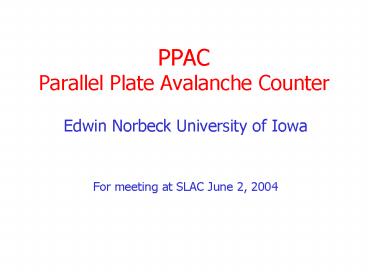PPAC Parallel Plate Avalanche Counter - PowerPoint PPT Presentation
1 / 15
Title:
PPAC Parallel Plate Avalanche Counter
Description:
Three flat plates, separated by 2 mm. Middle plate at high voltage ... to showers generated by the outer halo of the beam striking the beam pipe. ... – PowerPoint PPT presentation
Number of Views:205
Avg rating:3.0/5.0
Title: PPAC Parallel Plate Avalanche Counter
1
PPAC Parallel Plate Avalanche Counter
- Edwin Norbeck University of Iowa
- For meeting at SLAC June 2, 2004
2
Typical low-pressure PPAC
- Two flat plates
- Separated by 2 mm
- Filled with 10 torr isobutane
- MIPs often leave no signal
- 700 V between plates
- Timing resolution better than 300 ps
- Used with 50 MeV/nucleon heavy ions
3
PPAC in Calorimeter
- Three flat plates, separated by 2 mm
- Middle plate at high voltage
- Outer plates hold atmospheric pressure
- Filled with 10-40 torr of a suitable gas
- Gas flows in one side and out the other
- Timing resolution better than 300 ps
- Plate composition chosen to maximize signal,
i.e. maximize conversion of softphotons to
electrons
4
PPAC energy resolution
Poor for single heavy ion Current per mm2 is
huge! Same size signal from shower should have
good resolution. Measure resolution with double
PPAC Look at ratio between two sides
5
Iowa PPAC - a radiation hard detector
Double PPAC for testing energy and time
resolution. The PPAC detector concept can be
developed as a candidate for the luminosity
monitor.
6
Tests with double PPAC
- Test with EM showers using 80 ps bunches of 7 GeV
electrons from the Advanced Photon Source, at
Argonne National Laboratory - Planned test with low energy hadron showers using
the 120 GeV proton test beam at Fermilab
7
PPAC Test at ANL
- IOWA double PPAC was tested for energy and time
resolution with electron showers from the
Advanced Photon Source (APS) at Argonne National
Laboratory. - The booster ring of the APS puts out 76 ps
bunches of 7 GeV positrons at the rate of two per
second, with 3.6 x 1010 positrons in each bunch. - In normal operation the positrons are injected
into the main storage ring where they are used to
produce synchrotron radiation. - There are maintenance and development periods
during which the beam is directed into a beam
dump. We set up our equipment next to the beam
line just in front the beam dump. - The entire beam bunch has an energy of 2.5 x 1020
eV, or 2.5 x 108 TeV, much more than we needed.
8
Results of PPAC Test at ANL
- To make use of this beam we placed the PPAC close
to the beam line where it would be exposed to
showers generated by the outer halo of the beam
striking the beam pipe. Because of the small
angle between the positrons and the wall of the
beam pipe, the wall acted as an absorber with a
thickness of several centimeters. The showers
were developed in this absorber. - We expected the time resolution between the front
and back PPACs to be less than 300 ps. What we
found was 3 ns (FWHM). This is still a fast
signal even though it is an order of magnitude
slower than expected. - The poorer than expected time resolution was
caused by noise that required the discriminator
levels to be set high in order to eliminate
spurious events. - One source of noise was caused by the necessity,
because of safety regulations, to have the power
for the preamps near the beam line come from a
wall plug in the beam tunnel while the rest of
the electronics was powered from a wall plug in
the floor above.
9
Timing resolution
- A lower limit on the expected timing resolution
was measured by cross connecting timing signals
from alpha particles. The results are shown in
the next slide.
10
Timing resolution
s 95 ps
11
Energy Resolution Data of PPAC Test at ANL
Ratio Efront to Eback is constant to within 2
12
Electron and positive-ion currents
The electrons are collected in 1 ns. It is the
moving electrons that generate the signal that is
measured. The current from the slow moving
positive ions is smaller by a factor of a
thousand. We have looked at the positive-ion
signal using special electronics and find that it
lasts for about a microsecond.
13
Background reduction
The background can be reduced by subdividing the
detector into small sectors. One such design has
a single plate at high voltage and the grounded
plate divided into small segments, of perhaps 1.
cm2. With such a small area the plate spacing
would be reduced to 1 mm, which provides the
additional benefit of a faster signal. Of course,
the subdivision comes at the price of additional
electronics to measure the signal size of each
segment.
14
No Texas tower effect
With above-atmosphere hydrocarbon gasoccasional
proton from n-p scatteringgives huge signal. In
PPAC, proton hits wall at almost full
energy.PPAC signal mostly from low-energy
electrons. We will test this with detailed
simulations.(No multi-TeV hadron test beams.)
15
CONCLUSIONS
PPACs for sampling calorimeters
- Can be made radiation hard.
- Have good energy resolution.
- Are fastsubnano-second time resolution.
- Can be made to reject background.































